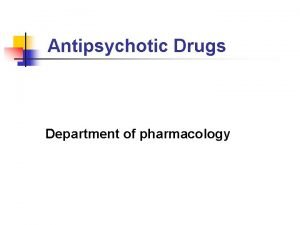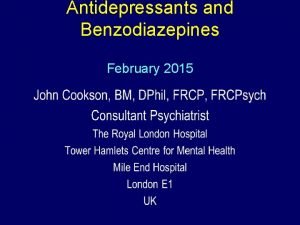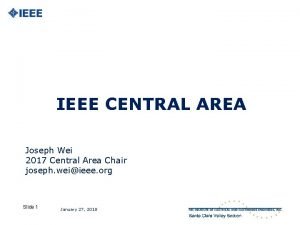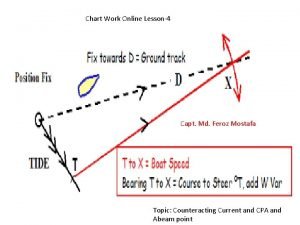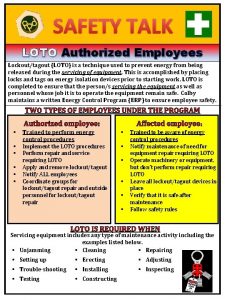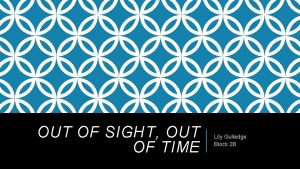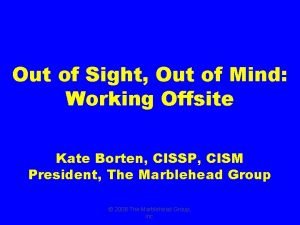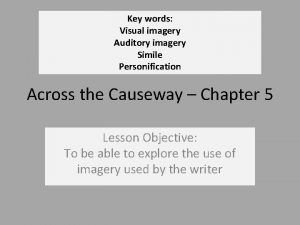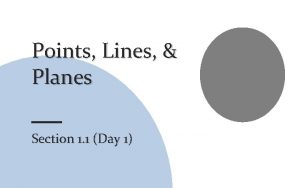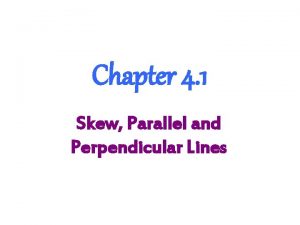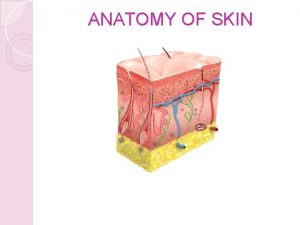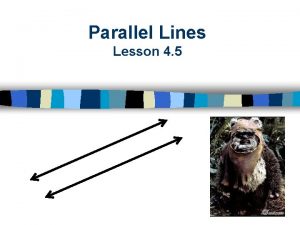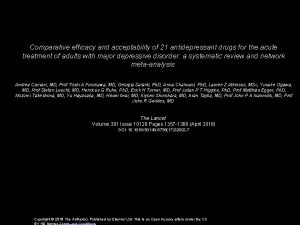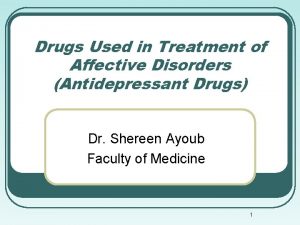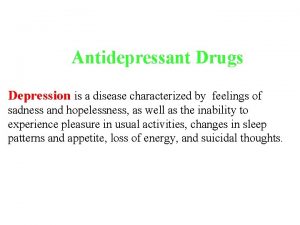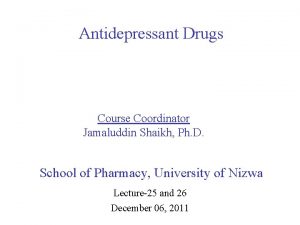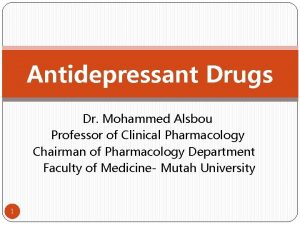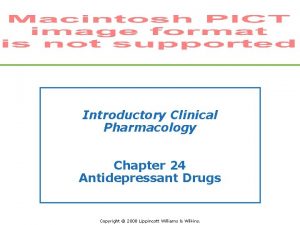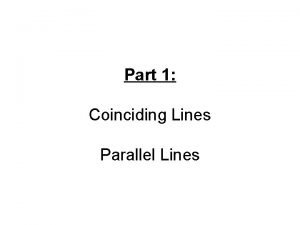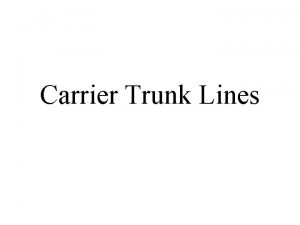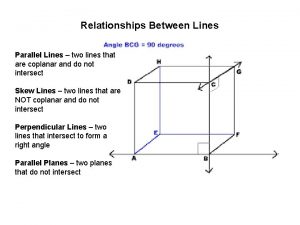Antidepressant drugs Dr safaa mostafa Out lines Introduction



































- Slides: 35

Antidepressant drugs Dr” safaa mostafa

Out lines: Introduction Classification of antidepressants: 1. Tricyclic antidepressants (TCAs). 2. Selective serotonin reuptake inhibitors (SRRIs). 3. Monoamine oxidase inhibitors (MAOIs). 4. Serotonin-norepinephrine reuptake inhibitors (SNRIs). Nursing intervention for side effect of antidepressants.

Introduction �Antidepressants are drugs that relieve the symptoms of depression. Classes of antidepressant agents are defined by their mechanism of action. �Depending on when they were first introduced, antidepressants are sometimes described as: �First: (tricyclic antidepressants (TCAs), or monoamine oxidase inhibitors (MAOIs) �Second: selective serotonin reuptake inhibitors (SRRIs) �Third generation antidepressants: known as serotonin- norepinephrine reuptake inhibitors (SNRIs).

Classification of antidepressants: 1. Tricyclic antidepressants (TCAs). 2. Selective serotonin reuptake inhibitors (SRRIs). 3. Monoamine oxidase inhibitors (MAOIs). 4. Serotonin-norepinephrine reuptake inhibitors (SNRIs).

Tricyclic antidepressants (TCAs). �Tricyclic antidepressants are the second oldest class of antidepressant drugs. Tricyclics block the reuptake of certain neurotransmitters such as norepinephrine (noradrenaline) and serotonin. They are used less commonly now due to the development of more selective and safer drugs.

The patient must take therapeutic dose of TCAs for 10 -14 day before these agents start to work it should be maintained for period of 3 -6 months after improvement. These agents are inexpensive, effective, relatively safe and easy to administer (oral administration).

Indication: 1. Major Depressive Disorder (MDD). 2. Dysthymia, and bipolar disorder (BD). 3. Obsessive-Compulsive Disorder (OCD) associated with depression. 4. Anxiety Disorder associated with depression. Eating Disorders like anorexia nervosa and bulimia � nervosa

1. Depression associated with dementia. 2. Attention-Deficit Hyperactivity Disorder (ADHD) and enuresis in children and adolescents. 3. Schizoaffective disorders. 4. Chronic Pain (for example, migraine, tension headaches, diabetic neuropathy, and post herpetic neuralgia).

Contraindication: 1. Hypersensitivity. 2. Impaired liver or renal function. 3. Acute recovery phase in myocardial infarction. 4. Can't be given with MAOIs. 5. Respiratory disorders, Hypertension, Hyper thyrodism, Glaucoma, and diabetes mellitus 6. Urinary retention or obstruction and benign prostatic hypertrophy

Side effects of tricyclic antidepressants 1 - Mild anticholinergic effects: Dry mouth, Blurred vision, Constipation Paralytic ileus, Urinary retention. Exacerbation of narrow angle glaucoma. 2 - Cardiovascular effect: Increased heart rate, Arrhythmia. Low blood pressure, which can cause lightheadedness.

3 - Central nervous system: Dizziness, Drowsiness, Headache Tremors, Seizures (particularly with maprotiline) Disorientation or confusion, Agitation and irritability. Mania and psychosis. 4 - Endocrine and sexual effect; Impotence, glactorrea, amenorrea. Increased appetite, Weight gain. Ejaculatory dysfunction and Delayed orgasm and low sex drive, in men.

5 - Allergic reaction: Skin rash or skin eruption. �* In Tricyclics, discontinuation syndrome symptoms include anxiety, insomnia, headache, nausea, malaise, or motor disturbance.

common Tricyclic Antidepressants

Selective serotonin re-uptake inhibitors (SSRIs) � The Selective serotonin reuptake inhibitors (SSRIs) are the class of antidepressants commonly used as the first line treatment for depression because they have a favorable side-effect profile and low toxicity.

Indication: 1. The main indication for SSRIs is clinical depression. Dysthymia. 2. Anxiety Disorders, such as social anxiety, panic disorders, obsessive– compulsive disorder (OCD), and occasionally, for posttraumatic stress disorder (PTSD). 3. Chronic Pain, Eating Disorders, agitation and gastrointestinal symptoms. 4. Attention deficit hyperactivity disorders. 5. Premenstrual Dysphoric disorders. 6. Effective as anti-phobic and anti-obsession.

Contraindication: 1. Contraindicated with: Mono amino oxidase inhibitors. 2. Cigarette smoking and alcoholism. 3. Tryptophan and lithium.

Side effects of (SSRIs) antidepressants 1 - Serotonin syndrome: A rare but life –threatening adverse reaction to SSRIs. Signs and symptoms: 1_Change in mental state (Anxiety) 2_Autonomic abnormalities (Hyperthermia, tachycardia 3_Neuromuscular excitement (Muscle rigidity 3)

2 - CNS effect: Agitation, tremors, headache, Nervousness, agitation or restlessness, Drowsiness, dizziness, insomnia, vided dreams, nightmares, seizures, electrolyte and glucose disturbance, endocrine and allergic reaction). 3 - GIT effects: �Anorexia, nausea, vomiting, constipation or diarrhea, dry mouth and throat. 4 - Sexual effects: �Inhibition of sexual orgasm and arousal (decreased libido).

The most common SSRIs

Serotonin-norepinephrine reuptake inhibitors (SNRIs).

Side effects of SNRIs: 1. Nausea, Dry Mouth, Constipation 2. Dizziness, Insomnia (numbness), Sleepiness 3. Increased Blood Pressure, Excessive Sweating 4. Tremor, Headache, Agitation 5. Muscle Weaknes

Monoamine oxidase inhibitor � MAOIs are not first-line drugs because patients who receive them must adhere to a low-tyramine diet to prevent hypertensive crisis and because MAOIs carry greater drug-interaction risks than do other medications as with certain analgesics (e. g. meperidine). MAOIs should be used when other treatments failed or contraindicated.

The most common MAOIs:

Indication: 1. Atypical form of depression. 2. Patient who are un responsive to other antidepressants. Contraindication: �Patient taking MAOIs must avoid food that containing tyramine such as: Mature and aged cheeses or dishes made with chees such as pizza. Aged meat such as sausage, salami, beef, and similar productions. Fish, chicken liver, chocolate, beans, ice cream, coffee, and tea.

Side effects Orthostatic hypotension is the most cardiovascular side effect and can be problematic in elderly and those with congestive heart failure. Weight gain, Insomnia, impotence ejaculation). Sedation and anticholinergic side effect. Hypertensive crisis. (delayed

Hypertensive crisis: �Normally MAO breakdown tyramine, however, because MAOIs inhibit MAO, tyramine can build up in body when person use this drug and eats tyramine containing foods at the same time. Tyramine also release epinephrine from nerve ending, these metabolic actions can precipitate hypertensive crisis. � Hypertensive crisis: �Is the most severe side effect. A sudden severe increase in blood pressure caused by high tyramine level, intracranial hemorrhage and death may result.

Signs and symptoms of hypertensive crisis: 1. Sudden elevation of blood pressure. 2. Explosive occipital headache. 3. Head and face flushed and feel 'full'. 4. Palpitation and chest pain. 5. Sweating, fever, nausea, and vomiting. 6_Dilated pupil and photophobia

Treatment of hypertensive crisis: 1. Stop MAOIs doses. 2. Monitor vital signs frequently. 3. Administer short acting antihypertensive medications as ordered by physician. 4. Do not lie down. 5. I. M chlorpromazine (antipsychotic) 100 mg, repeat if necessary. 6. I. V phentolamine, administer slowly in dose of 5 mg. 7. Manage fever by external cooling technique. 8. Evaluate diet adherence and teaching.

Drug interaction 1 - Serotonin or serotonergic syndrome result from taking a MAOIs and SSRIs in the same time or when one of these drugs too closes of the end of therapy with other. 2 - MAOIs are contraindicated for the patient who received some medication such as (amphetamine, ephedrine).

Nursing intervention for side effect of antidepressants. 1 - Anti-cholinergic side effect 1 - Dry mouth: Provide client with sugarless candy, ice. Instruct client to frequent sips of water. Ensure that client practice strict oral hygiene. 2 - Blurring of vision: Advice client not to drive a car until vision clear. Clear small items from pathway to prevent falls. Explain that these symptoms will subside after few weeks �

3 - Constipation: Order food high in fibers. Encourage increase physical activities if not contraindicated. Encourage increase fluid intake. 4 - Urinary retention: Instruct client to report any difficulty urination. Monitor intake and output. Various methods to stimulate urination may be tried as water in the path room or pouring water over pernial area

2 - Sedation: �Give the drug at bed time. �Instruct client not to drive or use dangerous machine while experiencing sedation. �Request that the physician decreased dose or ordered ales sedating drug. 3 - Orthostatic hypotension; 1. Instruct client to rise slowly from lying or sitting position. 2. Monitor blood pressure before giving medication each shift, document and report significant changes. 3. Avoid long hot shower or tub baths.

4 - Tachycardia and arrhythmia; �Monitor blood pressure, pulse and rhythm. 5 - Nausea: �Medication may be taken with food to minimize GIT distress. 6 - Insomnia and agitation: �Take dose early in day. �Avoid caffeine containing food and drinks. �Teach relaxation techniques to use before bed time.

7 - Weight gain: Weight client every day. - Order caloric-controlled diet. - Provide opportunity for physical activity. 8 - Photosensitivity: �Ensure that client wear protective sunscreen clothes and sun glasses while outdoors.

 Orthostatic hypotensin
Orthostatic hypotensin Classification of antidepressant
Classification of antidepressant Antidepressant side effects
Antidepressant side effects Antidepressant side effects
Antidepressant side effects Mostafa mortezaie
Mostafa mortezaie Mostafa abdallah
Mostafa abdallah Mostofa feroz
Mostofa feroz How to learn written english by mostafa kamal
How to learn written english by mostafa kamal Shot me out of the sky one direction
Shot me out of the sky one direction Remains simon armitage quotes
Remains simon armitage quotes Remains by simon armitage text
Remains by simon armitage text Who says put out the light and then put out the light
Who says put out the light and then put out the light The buzz saw snarled and rattled in the yard
The buzz saw snarled and rattled in the yard Out of sight out of mind psychology
Out of sight out of mind psychology Out out by robert frost analysis
Out out by robert frost analysis Loto safety talk
Loto safety talk Out out robert frost summary
Out out robert frost summary Lily gulledge
Lily gulledge Matt 11:28 msg
Matt 11:28 msg Loto
Loto Out, damned spot! out, i say!
Out, damned spot! out, i say! Henri fayol was a social scientist
Henri fayol was a social scientist Makna out of sight out of mind
Makna out of sight out of mind Log out tag out deutsch
Log out tag out deutsch An example of auditory imagery
An example of auditory imagery Worksheet 1-1 points lines and planes day 1
Worksheet 1-1 points lines and planes day 1 Skew line def
Skew line def Kraissl lines vs langer lines
Kraissl lines vs langer lines Parallel planes geometry
Parallel planes geometry Short break line definition
Short break line definition Horizontal line art definition
Horizontal line art definition Vertical angles
Vertical angles Peer review examples for students
Peer review examples for students Plane geometry real life example
Plane geometry real life example Body paragraph
Body paragraph Drug and alcohol jeopardy
Drug and alcohol jeopardy
